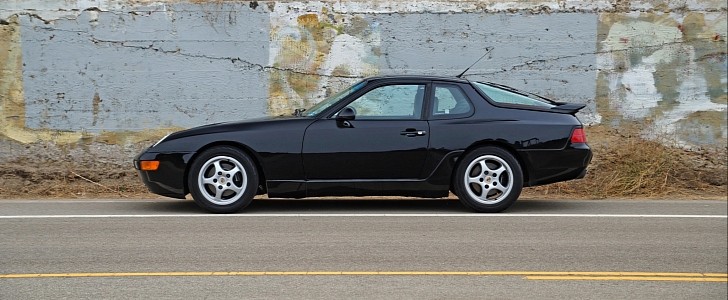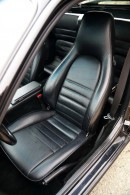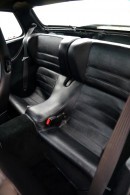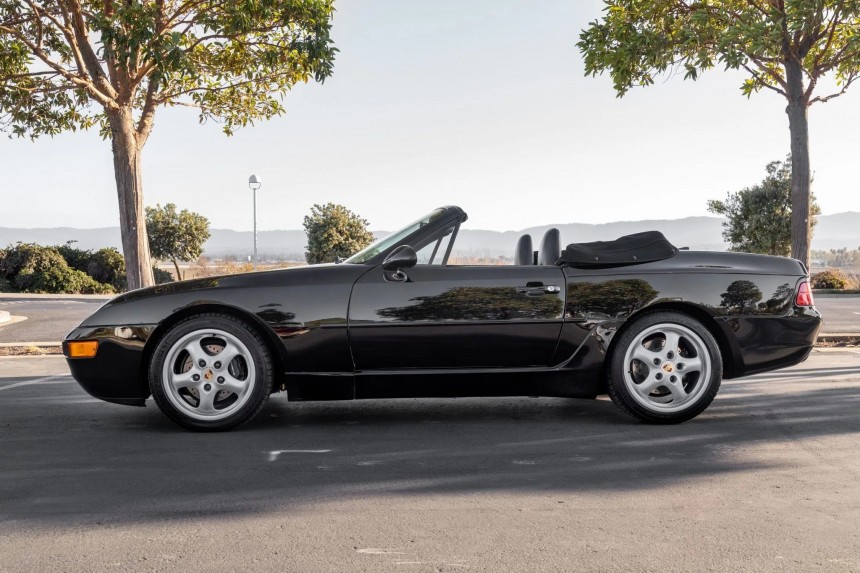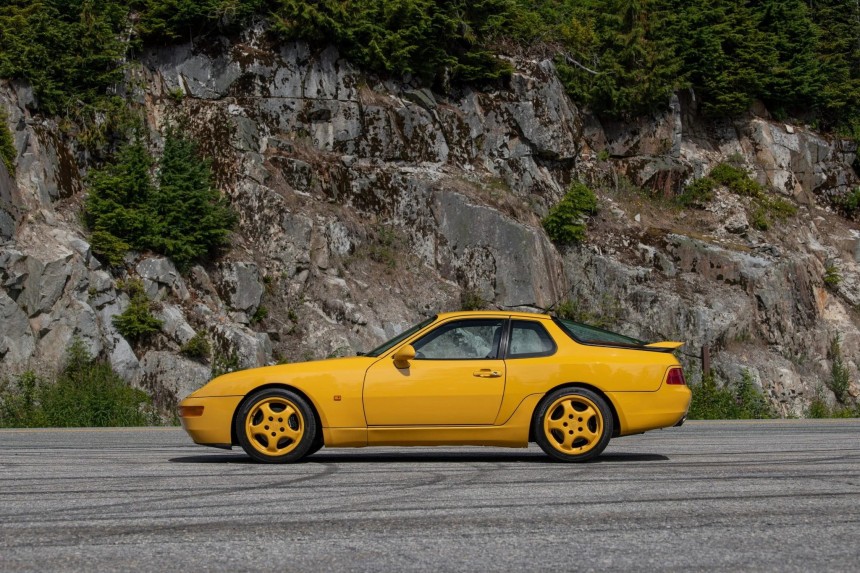Following the immense commercial success of the 924, the peeps at Porsche improved their entry-level model into the 944. But as the '80s turned into the '90s, Porsche understood that something had to change.
As the headline implies, the 968 was the last of its kind. The final evolution of the 924 platform, this car was designed on a tremendously small budget.
Porsche was financially troubled back then, so short on money that they were knocking on every imaginable door for engineering and production work. The four-ringed automaker of Ingolstadt and three-pointed star of Stuttgart were much obliged to collaborate with Porsche for the RS 2 Avant (built in Zuffenhausen) and the 500 E (in Sindelfingen and Zuffenhausen).
A transitional car that was indirectly replaced by the Boxster, the Neunsechsacht sold alongside the gray-haired 964 and 993, the last air-cooled Neunelfers. Not a coincidence, the front-end styling of the 968 is greatly inspired by the 928 we’ve covered in a previous article. The design was adapted for the 993 due to limited research and development money.
Constructed from steel, the unibody platform soldiered on with minimal changes from the 944. MacPherson struts and semi trailing arms, Sachs dampers, anti-roll bars fore and aft, four-piston brake calipers from Brembo, anti-lock technology from Bosch, as well as staggered wheels were used.
The 16-inch Cup Design five-spoke wheels that came standard measure seven inches up front and eight out back. Under the hood, the 968 rocks the M44/43 engine with VarioCam variable valve timing for improved torque lower down in the rev range. A 16-valve unit, this lump is managed by Bosch Motronic M2.10 instead of the previous-generation L-Jetronic. Gifted with forged pistons and connecting rods, the 3.0-liter engine flaunts a 104-millimeter bore and 88-mm stroke, translating to 4.1 and 3.4 inches.
As opposed to 208 horsepower at 5,800 revolutions per minute and 207 pound-feet (280 Nm) of torque at 4,000 revolutions per minute in the 944 S2, the 968 cranks out 237 horsepower at 6,200 revolutions per minute and 225 pound-feet (305 Nm) at 4,100 revolutions per minute. A six-ratio manual came standard while the four-speed automatic was optional. Marketed under the Tiptronic moniker, the replacement for the Sportomatic is a torque-converter automatic gearbox designed in collaboration with ZF.
Launched in August 1991 as a 1992 model, the 968 could be had as a coupe or canvas-top convertible. Tipping the scales at 1,370 and 1,440 kilograms (3,020 and 3,175 pounds), the 968 is slightly heavier than the 944 S2 it replaced. The Tiptronic added a further 60 kgs (132 lbs). The manual-equipped coupe is much obliged to reach 253 kilometers per hour (157 miles per hour) while the automatic option is obviously slower. The convertible, however, is the slowest of the bunch because of the aerodynamic penalty.
Updated with larger wheels for the 1993 model year, the front-engined sports car was also treated to a mobile phone module, fancier seats with heating, a pollen filter for the air conditioning system, and passenger airbags for RHD vehicles. A few more updates followed in 1994, including new stereos, electric seats, and the Sport Chassis that includes reinforced bushes, stiffer springs, adjustable dampers, adjustable spring plates, and beefier brakes.
Unveiled in October 1992, the 968 Club Sport aimed to save the poor sales of the regular model with better handling. Never sold in the United States due to the lack of federally-mandated safety features, the go-faster variant is easily identifiable thanks to body-color wheels and Club Sport decals in red, black, or white. Another telltale is the rear spoiler and the lack of a rear wiper. To reduce weight, Porsche used a smaller battery and less wiring.
Equipped with Recaro buckets wrapped in fabric upholstery, this fellow is 50 kilograms (110 pounds) lighter, slightly faster, and quicker as well. Be that as it may, Porsche had trouble selling it, exacerbating the poor sales record of the 968. The Turbo S followed suit in 1993, and you might be wondering if yours truly has forgotten something. The truth is, there never was a Turbo, which is pretty darn odd for the Stuttgart-based automaker.
Boasting 911 Turbo S brakes and larger wheels than those of the 968 Club Sport, the 968 Turbo S ditched the DOHC valvetrain and VarioCam system in favor of an eight-valve head and a KKK turbocharger. Augmented with Bosch DME multi-point fuel injection and a reinforced manual transmission, this mill is much obliged to develop 305 ponies at 5,600 revolutions per minute and 369 pound-feet (500 Nm) at 3,000 revolutions per minute.
Only 14 examples were produced, and once again, the Turbo S didn’t comply with the United States of America’s federal motor vehicle safety standards. Come summer 1995, a grand total of 12,776 968s were built.
Porsche was financially troubled back then, so short on money that they were knocking on every imaginable door for engineering and production work. The four-ringed automaker of Ingolstadt and three-pointed star of Stuttgart were much obliged to collaborate with Porsche for the RS 2 Avant (built in Zuffenhausen) and the 500 E (in Sindelfingen and Zuffenhausen).
A transitional car that was indirectly replaced by the Boxster, the Neunsechsacht sold alongside the gray-haired 964 and 993, the last air-cooled Neunelfers. Not a coincidence, the front-end styling of the 968 is greatly inspired by the 928 we’ve covered in a previous article. The design was adapted for the 993 due to limited research and development money.
Constructed from steel, the unibody platform soldiered on with minimal changes from the 944. MacPherson struts and semi trailing arms, Sachs dampers, anti-roll bars fore and aft, four-piston brake calipers from Brembo, anti-lock technology from Bosch, as well as staggered wheels were used.
As opposed to 208 horsepower at 5,800 revolutions per minute and 207 pound-feet (280 Nm) of torque at 4,000 revolutions per minute in the 944 S2, the 968 cranks out 237 horsepower at 6,200 revolutions per minute and 225 pound-feet (305 Nm) at 4,100 revolutions per minute. A six-ratio manual came standard while the four-speed automatic was optional. Marketed under the Tiptronic moniker, the replacement for the Sportomatic is a torque-converter automatic gearbox designed in collaboration with ZF.
Launched in August 1991 as a 1992 model, the 968 could be had as a coupe or canvas-top convertible. Tipping the scales at 1,370 and 1,440 kilograms (3,020 and 3,175 pounds), the 968 is slightly heavier than the 944 S2 it replaced. The Tiptronic added a further 60 kgs (132 lbs). The manual-equipped coupe is much obliged to reach 253 kilometers per hour (157 miles per hour) while the automatic option is obviously slower. The convertible, however, is the slowest of the bunch because of the aerodynamic penalty.
Updated with larger wheels for the 1993 model year, the front-engined sports car was also treated to a mobile phone module, fancier seats with heating, a pollen filter for the air conditioning system, and passenger airbags for RHD vehicles. A few more updates followed in 1994, including new stereos, electric seats, and the Sport Chassis that includes reinforced bushes, stiffer springs, adjustable dampers, adjustable spring plates, and beefier brakes.
Equipped with Recaro buckets wrapped in fabric upholstery, this fellow is 50 kilograms (110 pounds) lighter, slightly faster, and quicker as well. Be that as it may, Porsche had trouble selling it, exacerbating the poor sales record of the 968. The Turbo S followed suit in 1993, and you might be wondering if yours truly has forgotten something. The truth is, there never was a Turbo, which is pretty darn odd for the Stuttgart-based automaker.
Boasting 911 Turbo S brakes and larger wheels than those of the 968 Club Sport, the 968 Turbo S ditched the DOHC valvetrain and VarioCam system in favor of an eight-valve head and a KKK turbocharger. Augmented with Bosch DME multi-point fuel injection and a reinforced manual transmission, this mill is much obliged to develop 305 ponies at 5,600 revolutions per minute and 369 pound-feet (500 Nm) at 3,000 revolutions per minute.
Only 14 examples were produced, and once again, the Turbo S didn’t comply with the United States of America’s federal motor vehicle safety standards. Come summer 1995, a grand total of 12,776 968s were built.
